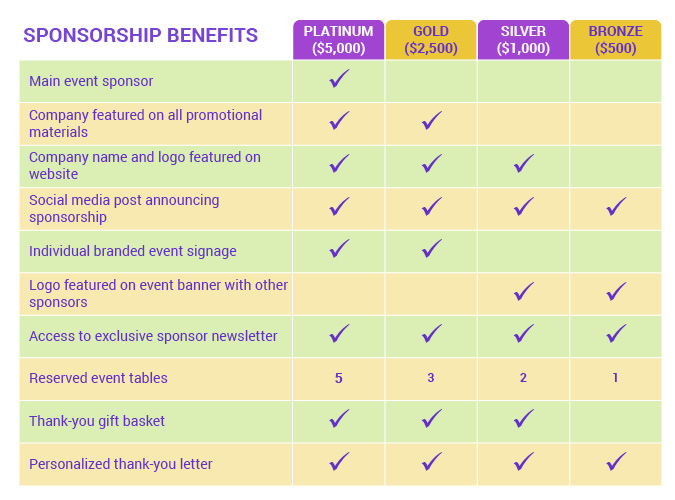How To Set Up Corporate Sponsorships for a Nonprofit Event


As part of a nonprofit organization, you’re well-acquainted with fundraising. You’ve probably experimented with several ways to get donations in the door, from online donations to recurring giving programs to pledge campaigns. But if you’ve exhausted every option and still want to see a thicker bottom line for your organization, it may be time to consider corporate sponsorships.


FREE Sponsorship Package Template
Use our sponsorship package template to structure your sponsorship deck and show why your mission is important, why sponsors should care, and what they’ll receive in exchange for their support
What do corporate sponsors want from nonprofits?
A corporate sponsorship is a relationship in which a business offers monetary donations or in-kind gifts of goods and services. In exchange, your nonprofit organization must publicly acknowledge the company’s contribution to your cause. Most often, you’ll see corporate sponsorships take two forms:
- Ongoing sponsors
Ongoing sponsors support nonprofits year-round through regular giving and involvement. This might include corporate social responsibility (CSR) campaigns, program sponsorships, in-kind gifts, pro-bono support, and ongoing fundraising efforts and campaigns. - Fundraising sponsors
Fundraising sponsors support a nonprofit through specific events or campaigns. The difference here is that support only lasts for a limited time. Corporations can donate money, volunteers, auction items, bar items, and so on. They might also underwrite expenses and offer their own services.
In this post, we’ll focus specifically on fundraising sponsorships for nonprofit events. Starting with this specific opportunity will be more manageable than trying to secure ongoing corporate sponsorships right off the bat.
So you can get ahead of the game for your next event, we’ll explore why you should pursue this funding opportunity and provide actionable steps for securing valuable corporate sponsorships.
The Benefits of Corporate Sponsorship for Nonprofits and Companies
One of the most enticing parts of corporate sponsorships is that it benefits both parties! When lined up correctly, your nonprofit can create enticing opportunities that amplify your event and create lasting relationships with companies.
Let’s break down the benefits for companies and nonprofits.
Benefits of Corporate Sponsorships for Companies
Before pitching to corporate sponsors, familiarize yourself with common benefits that inspire companies to support nonprofits like yours. That way, you can center your corporate sponsorship packages around these advantages and successfully secure more support. Double the Donation’s guide to corporate philanthropy dives into several advantages companies experience.
Here are some of the standard advantages:
- Brand awareness and goodwill:
By pairing their brand with yours, businesses can expect to receive some reflected glory from your noble cause, in addition to adding a corporate philanthropy facet to their brand. For instance, they might be labeled as a company that’s environmentally friendly, supports saving the whales, or aspires to help the poor. - Tax deductions:
In many jurisdictions, corporate tax breaks are available to businesses that donate to nonprofits. The larger the donation, the more significant the tax benefits. - Reputation:
Sponsoring a nonprofit event can improve the company’s reputation, appeal to favorable hiring prospects, and increase sales. - Employee and customer satisfaction:
Being associated with your nonprofit gives employees and customers something to be proud of. Companies that give back to their communities often boost employee retention and customer loyalty. - Reach new audiences:
Some of your regular supporters may already buy from your corporate sponsor, but not all of them. Co-branding through sponsorships helps businesses (especially local ones) reach new audiences.
Knowing what drives companies to support nonprofit events will help you create a stronger case for support. Highlight these when talking to potential companies to open the door for more corporate sponsorship opportunities.
Benefits of Corporate Sponsorships for Nonprofits
When you’re pitching the idea of corporate sponsorship to your board of directors or executive director, you’ll need to have everyone’s buy-in if you want to push the opportunity forward. Remember these points when it’s time to make the hard sell:
- Offset operating costs and expenses:
Funds from corporate sponsorship deals don’t necessarily have to go directly to programs. Cut overhead expenses by using donated goods, services, and funds. That way, you can tell smaller donors that 100% of their donations are going to your cause. - Access new volunteers:
Large sponsors often have large employee bases that may be interested in volunteering (or donating!). Chat with potential corporate sponsors about encouraging employees to make a quick donation, register to attend, or sign up to help out. - Brand awareness:
Piggyback on the notoriety of a large or well-known sponsor to give your small nonprofit more visibility. Your event sponsors will likely advertise that they gave to your event, bringing more attention to your event and cause. - Reach new audiences:
Similar to how companies can reach new customers, you can likely reach new supporters who may never have heard of your organization. These might be the company’s employees or customers.
As you can see, corporate sponsorships benefit nonprofits like yours beyond monetary support. When you put thought into these relationships, you can potentially expand your reach and connect with more supporters than ever.
Steps for Securing Corporate Sponsorships for Your Events
Before you go door to door looking for sponsors, it’s important to have a game plan. Just by knowing the benefits of corporate sponsorships, you’re off to a great start!
Remember, you’re talking to busy people who probably get requests for handouts every week, so your first impression needs to be on the mark. Follow these tips, and you’ll go into pitch meetings feeling confident.
1. Find the right corporate sponsor candidates.
While it’s exciting to line up corporate sponsorships, you don’t want funding from just any company. After all, they’ll be closely associated with your nonprofit’s event, which can impact your entire brand’s reputation.
Plus, randomly fishing for sponsors won’t generate many valuable results. Instead, identify high-value prospects from the start. Here’s how to create a list of valuable prospective sponsors:
- Start by exploring your connections. Look at your current supporters in your CRM to see where they work. If several supporters work for the same company, that’s a good indicator that the company’s mission aligns with your nonprofit. NPOInfo’s employer appends guide explains that if you’re missing employer information, you can use existing info (like email addresses and phone numbers) to find where they work!
- Consider the type of support you need. Do you need monetary or financial donations to reduce overhead costs? Or would your event benefit more from in-kind donations? If in-kind gifts would be more helpful, look to local and smaller businesses first. For example, sponsorship from a commercial printer company could be valuable if you promote your event with brochures. Or, a local winery could be an ideal corporate sponsor if you plan on having refreshments. Plus, local businesses are often easier to approach since they’ll likely be familiar with your cause.
- Research companies online. The internet is a powerful tool! Look at CEOs’ LinkedIn profiles to see if their personal causes align with your mission. Look for information about corporate philanthropy on their companies’ websites. Dig through your CRM to see if they’ve given in the past. Every bit of data you can glean from your research gets you one step closer to success.
The research phase of lining up corporate sponsorships for your event is paramount. This is what will set you up for successful conversations once you start reaching out, so don’t skimp on your research!
2. Create sponsorship packages.
Even local companies are approached by dozens of nonprofits each year for support. To help them see why your nonprofit’s event deserves their support, you’ll need enticing corporate sponsorship packages.
During and after your conversation with a corporate leader, they’ll need something tangible they can read over regarding the details of your pitch. This is known as your sponsorship package.
Here’s some basic information you should include:
- Pertinent information about your organization.
Describe your cause in a way that helps potential sponsors understand how your organization aligns with their priorities. - Details about your event.
Let them know the date, location, schedule, number of expected attendees, attendee demographics, and why you’re hosting the event. This will help a potential corporate sponsor envision their expanded audience. - Quantitative and qualitative benefits.
Explain what a company can expect from sponsoring your event. Think back to the corporate social responsibility benefits we discussed earlier. Reference how they might experience improved reputation, higher employee engagement, and tax incentives. - Sponsorship Levels.
If you create sponsorship levels or tiers, include pricing and the benefits for each one. For example, you might offer event naming opportunities, branded signage, recognition on your organization’s website, tickets to the event, reserved tables at the event, and so on.
Be sure to keep your event corporate sponsorship package concise, organized, and contemporary. You can use the same one for more than one potential sponsor, but always personalize it by using the specific company name, logo, and other details that make it seem like your pitch is tailored specifically for this business.


3. Find any connections to prospective sponsors.
You’re more likely to secure a corporate sponsorship if you have a direct connection to the company’s leadership. Think back to the research stage. Does anyone in your CRM work at your prospective corporate sponsors’ companies?
If a donor or board member can facilitate an introduction, that gives you an in with the company. It can reflect well on your organization and create a positive first impression if you have someone who’s passionate about your cause reach out on your behalf.
4. Reach out to potential corporate sponsors.
Your initial communication to a potential corporate sponsor doesn’t need to be War and Peace. A quick email with your sponsorship package attached is often enough to get the ball rolling.
Make sure you find the right contact by searching the company’s website or appending their email address. The company might even have a webpage dedicated to corporate giving that lists the appropriate contact. Then, you can draft an email to that individual.
Try something like this for contacts you don’t know personally:
Hi [name],
I noticed on your website that your company has been committed to supporting environmental work for the last decade. My organization is working on an event that aligns with your corporate responsibility philosophy, and I’m hoping you have time to sit down for a quick chat about how we can help each other.
Please let me know if you have time on Thursday afternoon to discuss this. I’ve attached some additional information for you to look over if you’re interested.
Thanks for your time.
Be sure to attach your sponsorship package to the email to give them additional details to look over. In any case, the more specific you can get with names and details, the better since it demonstrates that you have already put time into starting this relationship and you’re not just asking for a contribution. Flattery won’t get you everywhere, but it also can’t hurt.
5. Follow up with leads.
There is a solid chance that you won’t hear back from many of your contacts on the first try. People are busy and forget to reply. Some may even think you’re just after a quick donation. Don’t give up! Persistence is key. Following up is your best friend in this case
After a few days without a response, write a quick email that reiterates your pitch. If you feel particularly strongly about a prospective sponsor, you can even call their office. While calling is increasingly difficult these days, it’s still worth a shot. As you follow up, keep track of who you’ve contacted by creating a simple spreadsheet with these columns:
- Company Contacted
- Contact Information
- Date Contacted
- Result
If you’ve secured even one sponsor, don’t hesitate to mention the business by name when pitching a corporate sponsorship to other companies.
People want to feel part of a groundswell that leads to something good. Don’t discount the value of keeping up with the Joneses: seeing that other recognizable businesses are already on board will give you a great shot at securing even more sponsors.
6. Follow through on promises.
Once you line up your corporate sponsors, get creative promoting them and thanking them for their support online. Don’t forget to tag them in social media posts. Just be sure to double-check their social media handles first!
Essentially, follow through on anything you promised as part of your sponsorship package. You want to make a positive impression on their team from the very start. In turn, you might kick off an ongoing partnership that outlasts your event.
If you do a good job of ensuring their sponsorship is appreciated and vital to your success, you may accrue even more sponsors who cold call you!
Maintaining Relationships with Your Corporate Sponsors
“Sponsorship isn’t an item you check off and forget about. It’s a process.”
– Chris Baylis, President and CEO of Sponsorship Collective
Getting a corporate sponsorship and hosting a successful event is a ton of work. But you shouldn’t have to start from scratch every time. A little shepherding of your sponsors along the way will keep you from having to devote a lot of time to the pitch for your next event since you’ll have a bunch of warm leads.
Show your gratitude.
For many sponsors and donors in general, the most important thing you can do to secure their long-term support is to thank them. Profusely. Repeatedly. And sincerely.
Start with this handy thank-you letter template, but don’t stop there. Record a video of people your nonprofit has helped to thank your sponsors. Share event photos with thank-you messages. Send flowers! Any acknowledgment will be appreciated and make your job easier in the future.
Send a recap report.
The other major thing that sponsors want is to know their contribution to your event made a difference. Create a detailed recap report of your event, outlining why it was a success and how your sponsors contributed to that success.
To help your corporate sponsors visualize their tangible and positive impact, be sure to include:
Data collected like event attendance, money raised, and social media statistics
- Press coverage and sample ads
- Event photos and videos
Essentially, share anything interesting and positive that came from your event. You might also consider including some things that would be nice to have for your next event to get your sponsors in the mindset for continuing your relationship.
If you have a talented graphic designer on staff, make your report look visually captivating and professional. If you also have a web designer, make your report a slick webpage that you can use to promote your events to future sponsors.
Final Thoughts
We say it nearly every time here: record what you did for next time, including what worked and what didn’t. That way, you won’t have to start from scratch next time! If you’re adventurous, this is even an opportunity to do some A/B testing.
Benefits of Corporate Sponsorships
Corporate sponsorships can make a world of difference in your nonprofit’s fundraising events. Whether you need help reducing overhead or catering your event, companies can step in to save the day! It’s up to you to develop creative corporate sponsorship opportunities, find the right prospects, and convince them to get on board with your event. Just one solid sponsor is enough to make the difference between an event that’s fine and one that blows away everyone’s expectations.


FREE Sponsorship Package Template
Use our sponsorship package template to structure your sponsorship deck and show why your mission is important, why sponsors should care, and what they’ll receive in exchange for their support





